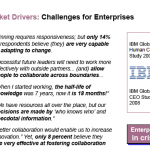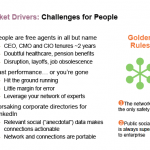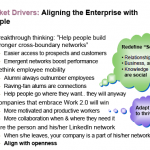 Alumni 2.0 Employer-Employee Realignment explains that the biggest misalignment at many organizations is with their employees—and how to realign.
Alumni 2.0 Employer-Employee Realignment explains that the biggest misalignment at many organizations is with their employees—and how to realign.
We have all heard about “Business-IT Alignment” ad nauseum through the 1990s and beyond (even today), but an even greater enterprise misalignment is fast approaching: human capital management. In the Knowledge Economy, large organizations and individuals are having to adjust to the changing employment paradigm which features increasing volatility and uncertainty. Enterprises need agility (read “the ability to fire and hire”) while employees need security (read “decent affordable healthcare and transition aid”). Each party will win when the transaction cost of finding new work situations falls. Therein lies the simple truth of the new realignment, and social networks should be put on the front lines.
Alumni 2.0 Defining Principles
Organizations and employees can help each other through Alumni 2.0 programs, which differ considerably from the legacy versions.
-
Employers and employees value the concept of lowering transaction costs so that each party can be more flexible.
- When the parties are aligned, each derives greater value from their relationship.
- Employers trust employees to manage their own careers and to seek greater opportunity, whether inside or outside the company.
- When employers are very supportive, employees will often feel goodwill toward the company and want to help it and former colleagues.
- By encouraging employees to connect with alumni and potential recruits through third party social networks, they will reduce transaction costs significantly, benefitting each party:
- Employer transaction costs will fall through increased alumni referrals for emerging employment needs; employers will be able to source a greater diversity of external consultants, diminishing employment
- Employee transaction costs will fall through the increased ability to find more appropriate work situations, within or without the company
- For the same reasons, this works to reduce the company’s business development costs:
- By remaining connected with alumni, many of whom transition to clients, customers and partners (yes, some will go to competitors but in most cases the company will gain much more than it loses), employees have the opportunity to serve as resources for alumni; they will discover business opportunities
-
Employees can proactively reach out to alumni to assist with business development initiatives, significantly reducing the “discovery” stage of business development
- A cornerstone of Alumni 2.0 is encouraging the use of third-party networks such as LinkedIn:
- In their profiles, employees present themselves as individuals to maximize their attractiveness, increasing their ability to attract business to the employer and additional opportunities outside the company
- Employees will be accessible to potential recruits and consultants who can help the company and grow its pipeline
- Employees will be accessible to alumni and able to help them solve challenges; many of these challenges will be relevant to the company’s business and will lead to business opportunities
- A third-party network provide continuity for the employee life cycle: recruit-employee-alumnus/a
Obstacles to Alumni 2.0
- Employers and employees have legacy feelings about employment: generalizing, it was often a rather paternalistic system that gave employers considerable control over employees and employees a sense of security and identity. Many employers and employees do not want to give this up, and some will oppose it because it threatens the status quo.
- Executives need to honestly ask themselves whether their business will experience less volatility moving forward:
- If they see less volatility, they might not see the need to diminish employment and business development transaction costs
- If they see more volatility (the majority will), they should strongly consider Alumni 2.0
- An even greater stumbling block is mid-level managers who are accustomed to a command-control style of management
-
Employees should ask themselves the same question. Do they see more instability in their careers or less? Most will see more and will have an interest in cutting their transaction costs of moving into different situations.
- Most people do not have a high level of awareness about how they create trusted relationships in general (offline). It is a very implicit activity. This creates a barrier when they try to use software to create and manage relationships online.
- Employers and employees need training about how to establish and maintain trust and how to share expertise appropriately, online and offline
- When employees understand social networks’ functionality and applicability to their jobs and careers, they can plan their activities and time better.
- Lack of trust between employers and employees. Each party has been witness to the death of the Industrial Economy employment paradigm since the 80s.
- Many employees are bitter and fearful, and they do not trust the employer to do right by them. This is a holdover from the paternalistic system. These feelings drastically reduce their willingness to help the company as alumni.
- Employers are struggling to maintain profitability in very difficult markets; likewise, they face shrinking talent pools and fear the loss of too many employees at the wrong time. They have high recruitment costs.
Parting Shots
- Also see Using Social Networks for National & Global Recruiting and Sales: Three-Stage Adoption Model
- Employers have the opportunity to take the lead and inspire employees by increasing support and transparency.
- Employees are increasingly in the networks anyway; why not help them to be more effective while engendering extensive goodwill?
- By promulgating a profile management program, while acknowledging that some employees will benefit through situations outside the company, employers can inspire employees, instill a sense of gratitude and show that a new model of relationship is dawning.
- More about Profile Management Programs here.




2009 Predictions and Recommendations for Web 2.0 and Social Networks…
Now that the Year in Review 2008 has summarized key trends, we are in excellent position for 2009 prognostications, so welcome to Part II. As all experienced executives know, risk and reward are inseparable twins, and periods of disruption el…
Enterprise Digital Social Networks: Executive Adoption Snapshot 2008…
2009 Poised as Inflection Point in Enterprise Usage—LinkedIn Increases Relevance to B2B Executives
During the 1990s, I was intimately involved with helping global organizati…
[…] As a general rule, extensive opportunity exists where you can use social media to cross boundaries, which usually impose high costs and prevent collaboration. One of the most interesting in 2009 will be encouraging alumni, employees and recruits to connect and collaborate according to their specific business interests. This can significantly reduce your organization’s business development, sales and talent acquisition costs. For more insight to this, see Alumni 2.0. […]
[…] firms, referral sources and intermediaries are often very important to business, too. In addition, think holistically about “employees,” whom you can now also engage hyper-efficiently while they are prospects and alumni (pre- and […]
[…] value chain partners, referral sources and communities are often critical. In addition, think holistically about “employees,” whom you can now also engage hyper-efficiently while they are prospects and alumni (pre- and […]
[…] firms, referral sources and intermediaries are often very important to business, too. In addition, think holistically about “employees,” whom you can now also engage hyper-efficiently while they are prospects and alumni (pre- and […]
[…] regulators, politicians, value chain partners, referral sources and communities. In addition, think holistically about “employees,” whom you can now also engage hyper-efficiently while they are prospects and alumni (pre- and […]